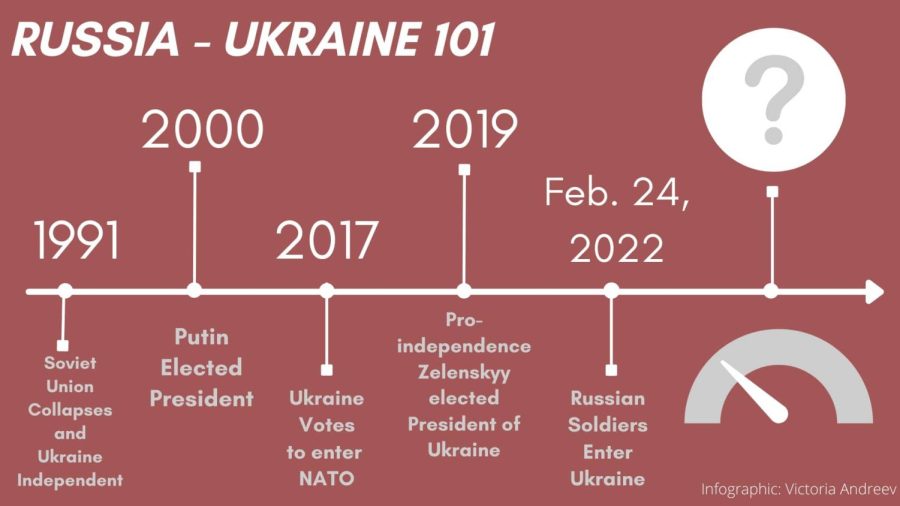Russia Invades Ukraine – Explained
The basics you need to understand what’s happening across the world
As Russia and Ukraine remain in conflict, Staff Writer Victoria Andreev writes about the events leading up to their current situation.
April 8, 2022
The once-anticipated “roaring twenties” of this century have been marked by turmoil as one humanitarian disaster leads to another. The world seemed to finally break past the COVID-19 wall and Americans watched gas prices level, but these circumstances only brought a sense of fragile stability.
This all changed on Feb. 24, when reports of a hundred thousand Russian troops moving into Ukraine shocked the entire world. Headlines of Russian President Vladimir Putin’s invasion have been splattered across every social media platform, but few people know about the complexities of the conflict itself or the decades of history foreshadowing the event.
As a child of Russian immigrants, I learned about the tensions with Ukraine growing up. My parents immigrated as refugees, meaning my childhood was full of horror stories from their lives in Russia. Growing up in the USSR, they personally witnessed the extent of communism’s devastation and felt like the country was finally evolving over the past decades.
Putin’s invasion has especially struck a chord with me, as it’s tough to watch my country and family suffer from the actions of a ruthless dictator. Because of this, I’ve been trying to talk to and inform some of my friends about what’s happening and figured there were definitely others interested in knowing what’s going on.
Throughout my effort to educate some of my friends about how and why the world is on fire, I’ve broken down the past thirty years into a basic timeline of important events for those who feel too behind to start paying attention.
Background
We’ve grown up in a time of relative stability with European countries, so to many younger Americans, this conflict seems completely random. The reality: three decades of disagreement between Ukraine and Russia. The year 1991 marked the collapse of the Soviet Union and subsequent independence for Ukraine, a blow that the USSR (and Putin) took poorly.
Like I said, the conflict isn’t as random as it seems. Despite a shared culture and likely relatives across the border, the two nations have long harbored tensions. The Russian government has consistently viewed Ukraine as still a part of Russia, while Ukrainianes hold strongly to their independent identity.
The conflict began to reach the surface in 2017 when Ukraine’s parliament formally voted to enter NATO.
(quick pause)
If you’ve heard someone say that word and ever nodded your head in oblivious agreement, you’re not even close to alone. NATO stands for the North Atlantic Treaty Organization. It’s a group of European countries, and America, that have entered a formal agreement to protect each other’s safety by providing support (troops, supplies, etc.) when needed. As of now, neither Russia nor Ukraine are not NATO members.
Putin Hits the Headlines
Russia strongly opposed Ukraine’s NATO application, attempting to stall it for years until making a public statement about their adamance against Ukraine’s membership in December 2021. Russia kept its word, and by mid-February, news broke that Putin had lined its border with over 100,000 troops.
Putin stands by his claims that this is simply a response to Ukraine’s encroachment on the two nations’ previously-established border with support from NATO. At first, Russian troops remained just before the border, as Putin consistently released threats to invade his neighbors unless Ukraine agreed to rejoin as a part of Russia.
Negotiations between the leaders of both countries immediately began, and the world swiftly turned its attention to Eastern Europe. The negotiations have repeatedly yielded no result, but because Ukraine is yet to enter NATO, other countries have offered relatively little support, as they have no obligations or previous agreements requiring them to do so. In addition, fear of Putin turning his attention to their countries if they were to involve their army prevents those countries from interfering.
Attempts to Stop Putin
While many have limited their military support of Russia, almost all major countries have completely cut ties with Russian banks, leaving its economy in shambles as the value of Russia’s currency, the ruble, rapidly loses value. The ruble lost almost half its value when it dropped from 72 Rubles to a dollar at the turn of 2022 to about 139 rubles to a dollar on March 7.
Previously, I mentioned my family connections in Russia, and although any trace of social media or foriegn news in Russia is now a crime punishable by jail time, the government has not cut its citizens’ communication with the outside world. This has allowed me to hear about conditions faced by the people living in Russia’s second biggest city, Saint Petersburg.
Economic sanctions—essentially government boycotts of the Russian economy—have been placed on Russia by nearly all European countries; the halt of global trade means necessary imports have stopped, leaving grocery store shelves bare and the government rationing almost every good to the minimum required to scrape by.
Although the Russian people are suffering, the economic blows have done little to stop Putin’s invasion, and a lack of substantial support from NATO has left Ukraine vulnerable in his eyes.
As of Now
The world will continue to focus on Eastern Europe for what is estimated to be months. The fate of the world will continue to sit in the hands of a handful people not too different from you and I, but for now, the most any of us can do is simply pay attention to how this plays out. Choosing to stand with Ukraine adds one more person that believes in the people of Ukraine as they fight to save themselves and their nation.
If you would like to learn more about more ways you can take action and support Ukraine, here’s a list of organizations providing relief to the Ukrainian people.










